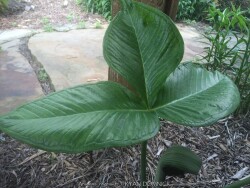

Japanese Cobra Lily (Arisaema ringens) is planted for its bright green foliage and bazaar "Cobra" hood-like flowers. Native to rich Japanese forests in humusy, medium to wet, well-drained soil in part shade to full shade, it needs a good location in the garden and will be a focal point. If foliage depreciates from drought, the plants may be cut to the ground with some regrowth and flowering possible in the fall. Combine with shade garden plants that will fill the space in summer such as hostas. Although this aroid offsetts, it is rare and uncommonly available for sale.
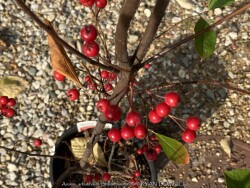

Red chokeberry (Aronia arbutifolia 'Brilliantissima'), is an open, upright, spreading, somewhat rounded but leggy, suckering, deciduous shrub that typically grows 6-10' tall. It is native to native to both wet and dry thickets in Eastern North America. This 3-season shrub had appeal from spring to late fall starting with white flowers, then deep green summer foliage followed by brilliant red fall color and red berries. Plant in groups or mass plantings in small gardens or open woodland areas. Ability to withstand wet conditions makes it suitable for growing on the margins of ponds, streams, or rain gardens. Watch out for deer can devour young plants (protect with chicken wire if needed) but established plantings can generally outgrow deer browsing which offer free pruning to prevent legginess. The common name of chokeberry is in reference to the tart and bitter taste of the fruits which are edible but so astringent as to cause choking in most of those who try: no it's not poison!. Fruits are renowned for its antioxidant rich berries and high nutritional value and sometimes used to make tasty jams and jellies if enough sugar is added. Included in our "edibles" database but depends on how hungry you are! Aronia arbutifolia 'Brilliantissima' grows slowly to 6-8' tall and is perhaps most noted for its attractive glossy red berries and red fall foliage color. It primarily differs from the species by being more compact. It producing more lustrous foliage with superior red fall color. It also produces larger, glossier and more abundant fruit favored by wildlife.
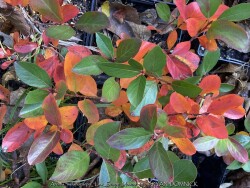

Low Scape Mound Aronia (Aronia melanocarpa 'Low Scape Mound') is a tidy little mound shaped deciduous shrub that typically grows 1-2' tall. It is native to low woods, swamps, bogs and moist thickets native from the Midwest to Canada. This 3-season shrub had appeal from spring to late fall starting with white flowers, then deep green summer foliage followed by brilliant red fall color and a few blackberries. Plant in small groups or mass plantings in small gardens. Ability to withstand wet conditions makes it suitable for growing on the margins of ponds, streams, or rain gardens. Despite 'Low Scape Mound' being touted as "drought tolerant", in the southern part of their range (Kansas), this chokeberry will decline in dry clay or alkaline soils. Watch out for deer and rabbits can devour young plants (protect with chicken wire if needed) but established plantings can generally outgrow browsing. The common name of chokeberry is in reference to the tart and bitter taste of the fruits which are edible but so astringent as to cause choking in most of those who try: no it's not poison!. Fruits are renowned for its antioxidant rich berries and high nutritional value and sometimes used to make tasty jams and jellies if enough sugar is added. Included in our "edibles" database but depends on how hungry you are! However, 'Low Scape Mound' is not grown for fruit production but rather as a compact landscape 3-season shrub tolerant of wet soils. All Proven Winners® plants are legally propagated, healthy and vigorous, true to name, and tagged with color pictures and growing information.


Low Scape Snowfire Aronia (Aronia melanocarpa 'Low Scape Snowfire') compact mound shaped deciduous shrub that typically grows 3-5' tall. It is native to low woods, swamps, bogs and moist thickets native from the Midwest to Canada. This 3-season shrub had appeal from spring to late fall starting with numerous white flowers, then deep green summer foliage followed by brilliant red fall color and a few blackberries. Plant in small groups or mass plantings in small gardens. Ability to withstand wet conditions makes it suitable for growing on the margins of ponds, streams, or rain gardens. Despite 'Low Scape Snowfire' being touted as "drought tolerant", in the southern part of their range (Kansas), this chokeberry will decline in dry clay or alkaline soils. Watch out for deer and rabbits can devour young plants (protect with chicken wire if needed) but established plantings can generally outgrow browsing. The common name of chokeberry is in reference to the tart and bitter taste of the fruits which are edible but so astringent as to cause choking in most of those who try: no it's not poison!. Fruits are renowned for its antioxidant rich berries and high nutritional value and sometimes used to make tasty jams and jellies if enough sugar is added. Included in our "edibles" database but depends on how hungry you are! However, 'Low Scape Snowfire' sets a heavy crop for fruit production but rather as a compact landscape 3-season shrub tolerant of wet soils. All Proven Winners® plants are legally propagated, healthy and vigorous, true to name, and tagged with color pictures and growing information.
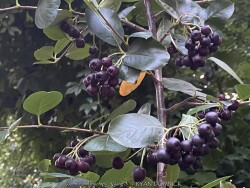

Black Chokeberry (Aronia melanocarpa), is an open, upright, spreading, somewhat rounded but leggy, suckering, deciduous shrub that typically grows 3-6' tall. It is native to low woods, swamps, bogs and moist thickets native from the Midwest to Canada. This 3-season shrub had appeal from spring to late fall starting with white flowers, then deep green summer foliage followed by brilliant red fall color and black berries. Plant in groups or mass plantings in small gardens or open woodland areas. Ability to withstand wet conditions makes it suitable for growing on the margins of ponds, streams, or rain gardens. Watch out for deer can devour young plants (protect with chicken wire if needed) but established plantings can generally outgrow deer browsing which offer free pruning to prevent legginess. The common name of chokeberry is in reference to the tart and bitter taste of the fruits which are edible but so astringent as to cause choking in most of those who try: no it's not poison!. Fruits are renowned for its antioxidant rich berries and high nutritional value and sometimes used to make tasty jams and jellies if enough sugar is added. Included in our "edibles" database but depends on how hungry you are! 'Viking' was developed in Europe for production of extra large dark purple-black fruit also used as a component of health drink juices. Aronia melanocarpa 'Viking' black chokeberry produces abundant fruit and improved fall color. Cross pollination on both varieties increases fruit production although both are self-fertile.
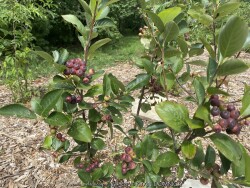

Black Chokeberry (Aronia melanocarpa), is an open, upright, spreading, somewhat rounded but leggy, suckering, deciduous shrub that typically grows 3-6' tall. It is native to low woods, swamps, bogs and moist thickets native from the Midwest to Canada. This 3-season shrub had appeal from spring to late fall starting with white flowers, then deep green summer foliage followed by brilliant red fall color and black berries. Plant in groups or mass plantings in small gardens or open woodland areas. Ability to withstand wet conditions makes it suitable for growing on the margins of ponds, streams, or rain gardens. Watch out for deer can devour young plants (protect with chicken wire if needed) but established plantings can generally outgrow deer browsing which offer free pruning to prevent legginess. The common name of chokeberry is in reference to the tart and bitter taste of the fruits which are edible but so astringent as to cause choking in most of those who try: no it's not poison!. Fruits are renowned for its antioxidant rich berries and high nutritional value and sometimes used to make tasty jams and jellies if enough sugar is added. Included in our "edibles" database but depends on how hungry you are! 'Viking' was developed in Europe for production of extra large dark purple-black fruit also used as a component of health drink juices.
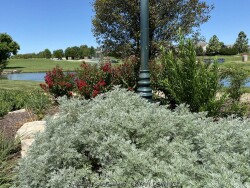

Powis Castle Artemisia (Artemisia 'Powis Castle') beautiful drought tolerant woody perennial valued for its finely dissected, aromatic, silver-gray foliage. It is evergreen down to 0 degrees F, if colder than -5degrees F, woody growth dies back too. Flowering is non-existant. As a perfect companion to vibrant flowering plants and ornamental grasses, it adds unique contrasting color and texture to waterwise landscapes. Most artemisias are best grown in poor to moderately fertile, dry to medium moisture, well-drained soils in full sun. In order to avoid occasional winter-kill in Kansas landscapes, it is advisable to plant on a south, east or west side of house or on south facing slopes or berms. Excellent soil drainage is essential for growing this plant well as poor lanky growth and root rot will occur in moist to wet soils. Tolerant of part-shade if kept dry. Cut back to 3-6" in early spring after dried winter silvery foliage stops looking attractive. New growth will emerge from the crown in mid-spring. If low temperatures hit -10 degrees F, it may kill an un-mulched plant; protect any zone 6 perennial with thick layer of mulch. General foliage decline may occur in hot and humid summer climates of the Southeast US but this is rarely a problem in Kansas or Oklahoma.
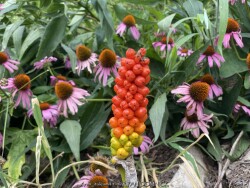

Italian Painted Arum (Arum italicum 'Pictum') is native to the Mediterranean region. It has a reversed or off-schedule life cycle; growing when other plants have already shed their leaves to take advantage of sunlight and lack of competition. It is often planted for its unusual evergreen leaf pattern and color resembling a bright green house plant growing outside in winter. Foliage goes dormant by June but is followed by naked stalks emerging from the ground with reddish orange berries. Foliage re-appears in fall and lasts well into winter untouched. If low temperatures hit 0 degrees F, foliage finally dies back to the ground and re-emerges in early spring to repeat the life cycle. If low temperatures hit -15 degrees F, it may kill an un-mulched plant; protect any zone 5/6 perennial with a 2-3" thick layer of mulch. Grow in average to rich well drained garden soil in full sun or full shade with everything in between. Moderate dry shade does not seem to be a problem because arum goes dormant anyways in the heat of summer. This holds true for planting in sunny locations to. Combine with shade garden plants that will fill the space in summer such as hostas or solomon seal. Also great when combined with late-emerging spring perennials (like plumbago, hardy hibiscus, and orange butterfly weed) because it fills that early spring space starting to grow extremely early with freeze-resistant foliage. Then later in the summer when Arum goes dormant, these plants hide the dying foliage and void left in the garden; what a great way for two species to share the same garden space! It has potential to be invasive in parts of the country such as the Pacific Northeast USA but not in Kansas. It is very stable but does not self-seed or spread in Lawrence, KS gardens; bulb offsets develop but only thicken the existing clump over time. Considered to be a great permatanet multi-season perennial for your garden.
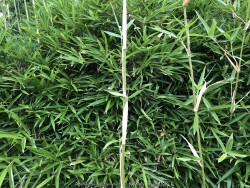

Arundinaria gigantea is also called Canebrake (a tall thicket of any of a variety of Arundinaria) This species, along with its shorter form, 'Tecta', are the only bamboos native to the United States. It once covered huge swaths of rich bottomland along stream valleys and ravines throughout the southeastern United States but have been widely replaced by agriculture. Although still seen in small patches, it can reproduce asexually and rapidly. This adaptation that allows them to persist quietly in the shade of a forest for years and rapidly take advantage of disturbance which disrupts the overstory, such as blowdowns, floods or hurricanes. As a landscape plant, use the same as you would use oriental bamboo in large areas for a evergreen noise, wind, visual screening. Foliage is evergreen to 0 to 5 degrees F. Canes will defoliate at -5 to -10 degrees F. Canes die to the ground at -10 to -15 degrees. Root system will survive up to -25 to -30 degrees F as a perennial especially if mulched. Arundinaria gigantea usually grows 10-15' feet tall in Kansas. Every few years a grove will experience complete winterkill: it is strongly advised to cut all dead growth to the ground for aesthetic reasons and and fire prevention. The 'Tecta' form looks similar but only grows 6-8 feet tall and is tolerant of wet soil.
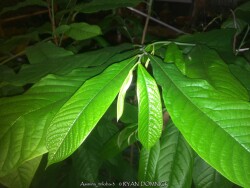

Paw Paw (Asimina triloba) is a tropical looking native understory fruit tree with large green leaves and delicious fruits. Flowers are born on old wood in the early spring and the maroon color is common of flowers meant to attract flies for pollination. Foliage is up to 12 inches long and turns a brilliant yellow in autumn for a couple weeks before falling. If cross pollination occurs, delicious fruits are produced in small clusters. The texture is custard like and taste is a mix between banana, mango, and hint of pineapple. Fruit is very fragile upon ripening and will fall to the ground and splat or be quickly devoured by animals. It is suggested that you put fruit nets around the clusters of fruit or harvest a few days earlier and allow to ripen inside. Fruit is rarely commercially available due to its fragility and short shelf-life. Cleaned fruit may be peeled frozen with seed intact: they can be picked out much easier when thawed out again Paw Paw may be eaten fresh, baked into desserts, or made into ice cream. Paw Paw is native to a large geographical area over eastern United States including Kansas. In the wild, Paw Paw grows in moist rich forest valleys in full to part shade. Best fruiting specimens can also be found on the edge of woodland or clearing in rich soil. Paw Paw tree colonies slowly spread by rhizomes and seem to occupy the forest understory sometimes for decades or centuries waiting for an opening to allow sunlight in. If a large canopy tree (such as an oak) dies or wind storm rolls through clearing a patch, new sunlight and an opening in the canopy occurs paving the way for sexual reproduction to take place (fruits) Paw Paw is somewhat tolerant of poorly drained soil's including clay but growth will be much slower. Interestingly, Paw Paws will tolerate and even need full sun when older to produce fruit. However, young saplings will quickly die in full sun from leaf burn and drought stress. If a tree is at least 4 to 6 tall and is planted in rich soil and full sun with regular irrigation, it will probably be fine. With these growing conditions, trees may grow at a median growth rate instead of slow, putting up 1 to 2 feet of new growth per year. If you have the right conditions for a Paw Paw tree, it should definitely be a part of your landscape whether you are growing for fruit production or not. There are dozens on improved cultivars available now days. In our Lawrence, KS display gardens, we are trialing several of these improved fruiting cultivars from Forrest Keeling Nursery in Missouri.
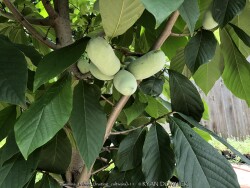

Paw Paw (Asimina triloba) is a tropical looking native understory fruit tree with large green leaves and delicious fruits. Flowers are born on old wood in the early spring and the maroon color is common of flowers meant to attract flies for pollination. Foliage is up to 12 inches long and turns a brilliant yellow in autumn for a couple weeks before falling. If cross pollination occurs, delicious fruits are produced in small clusters. The texture is custard like and taste is a mix between banana, mango, and hint of pineapple. Fruit is very fragile upon ripening and will fall to the ground and splat or be quickly devoured by animals. It is suggested that you put fruit nets around the clusters of fruit or harvest a few days earlier and allow to ripen inside. Fruit is rarely commercially available due to its fragility and short shelf-life. Cleaned fruit may be peeled frozen with seed intact: they can be picked out much easier when thawed out again Paw Paw may be eaten fresh, baked into desserts, or made into ice cream. Paw Paw is native to a large geographical area over eastern United States including Kansas. In the wild, Paw Paw grows in moist rich forest valleys in full to part shade. Best fruiting specimens can also be found on the edge of woodland or clearing in rich soil. Paw Paw tree colonies slowly spread by rhizomes and seem to occupy the forest understory sometimes for decades or centuries waiting for an opening to allow sunlight in. If a large canopy tree (such as an oak) dies or wind storm rolls through clearing a patch, new sunlight and an opening in the canopy occurs paving the way for sexual reproduction to take place (fruits) Paw Paw is somewhat tolerant of poorly drained soil's including clay but growth will be much slower. Interestingly, Paw Paws will tolerate and even need full sun when older to produce fruit. However, young saplings will quickly die in full sun from leaf burn and drought stress. If a tree is at least 4 to 6 tall and is planted in rich soil and full sun with regular irrigation, it will probably be fine. With these growing conditions, trees may grow at a median growth rate instead of slow, putting up 1 to 2 feet of new growth per year. If you have the right conditions for a Paw Paw tree, it should definitely be a part of your landscape whether you are growing for fruit production or not. There are dozens on improved cultivars available now days. In our Lawrence, KS display gardens, we are trialing several of these improved fruiting cultivars from Forrest Keeling Nursery in Missouri. Asimina triloba 'Mango' features exceptionally large fruit with flavorful yellow flesh. This has the most vigorous growth of pawpaw varieties. Fruit is late ripening.
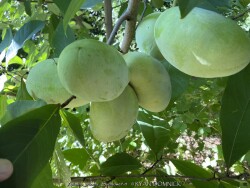

Paw Paw (Asimina triloba) is a tropical looking native understory fruit tree with large green leaves and delicious fruits. Flowers are born on old wood in the early spring and the maroon color is common of flowers meant to attract flies for pollination. Foliage is up to 12 inches long and turns a brilliant yellow in autumn for a couple weeks before falling. If cross pollination occurs, delicious fruits are produced in small clusters. The texture is custard like and taste is a mix between banana, mango, and hint of pineapple. Fruit is very fragile upon ripening and will fall to the ground and splat or be quickly devoured by animals. It is suggested that you put fruit nets around the clusters of fruit or harvest a few days earlier and allow to ripen inside. Fruit is rarely commercially available due to its fragility and short shelf-life. Cleaned fruit may be peeled frozen with seed intact: they can be picked out much easier when thawed out again Paw Paw may be eaten fresh, baked into desserts, or made into ice cream. Paw Paw is native to a large geographical area over eastern United States including Kansas. In the wild, Paw Paw grows in moist rich forest valleys in full to part shade. Best fruiting specimens can also be found on the edge of woodland or clearing in rich soil. Paw Paw tree colonies slowly spread by rhizomes and seem to occupy the forest understory sometimes for decades or centuries waiting for an opening to allow sunlight in. If a large canopy tree (such as an oak) dies or wind storm rolls through clearing a patch, new sunlight and an opening in the canopy occurs paving the way for sexual reproduction to take place (fruits) Paw Paw is somewhat tolerant of poorly drained soil's including clay but growth will be much slower. Interestingly, Paw Paws will tolerate and even need full sun when older to produce fruit. However, young saplings will quickly die in full sun from leaf burn and drought stress. If a tree is at least 4 to 6 tall and is planted in rich soil and full sun with regular irrigation, it will probably be fine. With these growing conditions, trees may grow at a median growth rate instead of slow, putting up 1 to 2 feet of new growth per year. If you have the right conditions for a Paw Paw tree, it should definitely be a part of your landscape whether you are growing for fruit production or not. There are dozens on improved cultivars available now days. In our Lawrence, KS display gardens, we are trialing several of these improved fruiting cultivars from Forrest Keeling Nursery in Missouri. Asimina triloba 'Sunflower' is a well-known, hardy selection originally from Chanute, Kansas. It ripens later than other varieties with large, flavorful fruit and is at lease partially self-fertile. Fruit has been described as tasting of mango, apricot, pineapple, banana and vanilla.


Paw Paw (Asimina triloba) is a tropical looking native understory fruit tree with large green leaves and delicious fruits. Flowers are born on old wood in the early spring and the maroon color is common of flowers meant to attract flies for pollination. Foliage is up to 12 inches long and turns a brilliant yellow in autumn for a couple weeks before falling. If cross pollination occurs, delicious fruits are produced in small clusters. The texture is custard like and taste is a mix between banana, mango, and hint of pineapple. Fruit is very fragile upon ripening and will fall to the ground and splat or be quickly devoured by animals. It is suggested that you put fruit nets around the clusters of fruit or harvest a few days earlier and allow to ripen inside. Fruit is rarely commercially available due to its fragility and short shelf-life. Cleaned fruit may be peeled frozen with seed intact: they can be picked out much easier when thawed out again Paw Paw may be eaten fresh, baked into desserts, or made into ice cream. Paw Paw is native to a large geographical area over eastern United States including Kansas. In the wild, Paw Paw grows in moist rich forest valleys in full to part shade. Best fruiting specimens can also be found on the edge of woodland or clearing in rich soil. Paw Paw tree colonies slowly spread by rhizomes and seem to occupy the forest understory sometimes for decades or centuries waiting for an opening to allow sunlight in. If a large canopy tree (such as an oak) dies or wind storm rolls through clearing a patch, new sunlight and an opening in the canopy occurs paving the way for sexual reproduction to take place (fruits) Paw Paw is somewhat tolerant of poorly drained soil's including clay but growth will be much slower. Interestingly, Paw Paws will tolerate and even need full sun when older to produce fruit. However, young saplings will quickly die in full sun from leaf burn and drought stress. If a tree is at least 4 to 6 tall and is planted in rich soil and full sun with regular irrigation, it will probably be fine. With these growing conditions, trees may grow at a median growth rate instead of slow, putting up 1 to 2 feet of new growth per year. If you have the right conditions for a Paw Paw tree, it should definitely be a part of your landscape whether you are growing for fruit production or not. There are dozens on improved cultivars available now days. In our Lawrence, KS display gardens, we are trialing several of these improved fruiting cultivars from Forrest Keeling Nursery in Missouri. Asimina triloba 'Sunflower' is a well-known, hardy selection originally from Chanute, Kansas. It ripens later than other varieties with large, flavorful fruit and is at lease partially self-fertile. Fruit has been described as tasting of mango, apricot, pineapple, banana and vanilla.
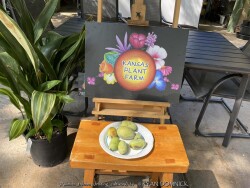

Paw Paw (Asimina triloba) is a tropical looking native understory fruit tree with large green leaves and delicious fruits. Flowers are born on old wood in the early spring and the maroon color is common of flowers meant to attract flies for pollination. Foliage is up to 12 inches long and turns a brilliant yellow in autumn for a couple weeks before falling. If cross pollination occurs, delicious fruits are produced in small clusters. The texture is custard like and taste is a mix between banana, mango, and hint of pineapple. Fruit is very fragile upon ripening and will fall to the ground and splat or be quickly devoured by animals. It is suggested that you put fruit nets around the clusters of fruit or harvest a few days earlier and allow to ripen inside. Fruit is rarely commercially available due to its fragility and short shelf-life. Cleaned fruit may be peeled frozen with seed intact: they can be picked out much easier when thawed out again Paw Paw may be eaten fresh, baked into desserts, or made into ice cream. Paw Paw is native to a large geographical area over eastern United States including Kansas. In the wild, Paw Paw grows in moist rich forest valleys in full to part shade. Best fruiting specimens can also be found on the edge of woodland or clearing in rich soil. Paw Paw tree colonies slowly spread by rhizomes and seem to occupy the forest understory sometimes for decades or centuries waiting for an opening to allow sunlight in. If a large canopy tree (such as an oak) dies or wind storm rolls through clearing a patch, new sunlight and an opening in the canopy occurs paving the way for sexual reproduction to take place (fruits) Paw Paw is somewhat tolerant of poorly drained soil's including clay but growth will be much slower. Interestingly, Paw Paws will tolerate and even need full sun when older to produce fruit. However, young saplings will quickly die in full sun from leaf burn and drought stress. If a tree is at least 4 to 6 tall and is planted in rich soil and full sun with regular irrigation, it will probably be fine. With these growing conditions, trees may grow at a median growth rate instead of slow, putting up 1 to 2 feet of new growth per year. If you have the right conditions for a Paw Paw tree, it should definitely be a part of your landscape whether you are growing for fruit production or not. There are dozens on improved cultivars available now days. In our Lawrence, KS display gardens, we are trialing several of these improved fruiting cultivars from Forrest Keeling Nursery in Missouri.


Paw Paw (Asimina triloba) is a tropical looking native understory fruit tree with large green leaves and delicious fruits. Flowers are born on old wood in the early spring and the maroon color is common of flowers meant to attract flies for pollination. Foliage is up to 12 inches long and turns a brilliant yellow in autumn for a couple weeks before falling. If cross pollination occurs, delicious fruits are produced in small clusters. The texture is custard like and taste is a mix between banana, mango, and hint of pineapple. Fruit is very fragile upon ripening and will fall to the ground and splat or be quickly devoured by animals. It is suggested that you put fruit nets around the clusters of fruit or harvest a few days earlier and allow to ripen inside. Fruit is rarely commercially available due to its fragility and short shelf-life. Cleaned fruit may be peeled frozen with seed intact: they can be picked out much easier when thawed out again Paw Paw may be eaten fresh, baked into desserts, or made into ice cream. Paw Paw is native to a large geographical area over eastern United States including Kansas. In the wild, Paw Paw grows in moist rich forest valleys in full to part shade. Best fruiting specimens can also be found on the edge of woodland or clearing in rich soil. Paw Paw tree colonies slowly spread by rhizomes and seem to occupy the forest understory sometimes for decades or centuries waiting for an opening to allow sunlight in. If a large canopy tree (such as an oak) dies or wind storm rolls through clearing a patch, new sunlight and an opening in the canopy occurs paving the way for sexual reproduction to take place (fruits) Paw Paw is somewhat tolerant of poorly drained soil's including clay but growth will be much slower. Interestingly, Paw Paws will tolerate and even need full sun when older to produce fruit. However, young saplings will quickly die in full sun from leaf burn and drought stress. If a tree is at least 4 to 6 tall and is planted in rich soil and full sun with regular irrigation, it will probably be fine. With these growing conditions, trees may grow at a median growth rate instead of slow, putting up 1 to 2 feet of new growth per year. If you have the right conditions for a Paw Paw tree, it should definitely be a part of your landscape whether you are growing for fruit production or not. There are dozens on improved cultivars available now days. In our Lawrence, KS display gardens, we are trialing several of these improved fruiting cultivars from Forrest Keeling Nursery in Missouri.
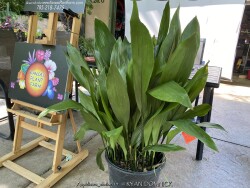

Cast-iron Plant (Aspidistra elatior) is a beautiful perennial and warmer climates for full shade. The leaves are glossy green perched on narrow stems with fat leaf blades. Unfortunately in our zone 6 Kansas climate, they cannot reliably be used as a perennial here. Most broadleaf evergreen plants are difficult to push the envelope with colder zones because evergreen leaves are more expensive to replace than for deciduous plants. (slower and requires more energy from the plant) Evergreen leaves are not intended to have to be replaced every year. In my father's zone 7a Stillwater Oklahoma garden, Cast-iron Plant can reliably be used as a perennial there but are dwarfed to about 1/2 size of normal. Anywhere south of zone 7b, count on it as a bullet-proof evergreen perennial! As a potted patio plant for full shade, they are wonderful. Grown in a raised pot, they are hardy to about 15-20° so you may be able to miss the first few frosts when moving them in for the winter. Before extreme cold (lower than 10 degrees F), they must be moved and overwintered in a dark garage or basement with monthly watering or bright window as a winter-only houseplant. Either way, they will hold up very well in the winter and maintain attractive foliage. When grown as a permanent house plant, they will last many years is grown in a bright indirect area. When Cast-iron Plant is grown as a permanent houseplant, you will need to watch for spider mites and possibly scale after a few years. Taking the whole plant outside and spraying with water a few times a year will help. Spider mites thrive and dry dusty conditions with low humidity (such as your house). Overall, Cast-iron Plants are very easy to grow hence their name. They will tolerate lower light than just about any house plant but after a few years, even this plant will decline unless given a summer growing season under a shaded tree or brighter conditions inside the house. New leaves grow about once per year and gradually the plant will need to be repotted as it is possible for them to split the container. This is a great time to divide the root system and get several new plants. This is one of our all-time favorite house plants.
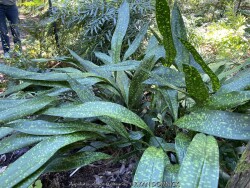

Cast-iron Plant (Aspidistra sp.) is a beautiful perennial and warmer climates for full shade. The leaves are glossy green perched on narrow stems with fat leaf blades. Unfortunately in our zone 6 Kansas climate, they cannot reliably be used as a perennial here. Most broadleaf evergreen plants are difficult to push the envelope with colder zones because evergreen leaves are more expensive to replace than for deciduous plants (slower and requires more energy from the plant). As a potted patio plant for full shade, they are wonderful. Grown in a raised pot, they are hardy to about 20-25° so you may be able to miss the first few frosts when moving them in for the winter. Before extreme cold (lower than approx.15 degrees F), they must be moved and overwintered in a dark garage or basement with monthly watering or bright window as a winter-only houseplant. Either way, they will hold up very well in the winter and maintain attractive foliage. When grown as a permanent house plant, they will last many years is grown in a bright indirect area. When Cast-iron Plant is grown as a permanent houseplant, you will need to watch for spider mites and possibly scale after a few years. Taking the whole plant outside and spraying with water a few times a year will help. Spider mites thrive and dry dusty conditions with low humidity (such as your house). Overall, Cast-iron Plants are very easy to grow hence their name. They will tolerate lower light than just about any house plant but after a few years, even this plant will decline unless given a summer growing season under a shaded tree or brighter conditions inside the house. New leaves grow about once per year and gradually the plant will need to be repotted as it is possible for them to split the container. This is a great time to divide the root system and get several new plants. This is one of our all-time favorite house plants.
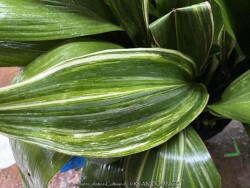

Cast-iron Plant (Aspidistra elatior cultivars) is a beautiful perennial and warmer climates for full shade. The leaves are glossy green perched on narrow stems with fat leaf blades. Unfortunately in our zone 6 Kansas climate, they cannot reliably be used as a perennial here. Most broadleaf evergreen plants are difficult to push the envelope with colder zones because evergreen leaves are more expensive to replace than for deciduous plants (slower and requires more energy from the plant). As a potted patio plant for full shade, they are wonderful. Grown in a raised pot, they are hardy to about 15-20° so you may be able to miss the first few frosts when moving them in for the winter. Before extreme cold (lower than 10 degrees F), they must be moved and overwintered in a dark garage or basement with monthly watering or bright window as a winter-only houseplant. Either way, they will hold up very well in the winter and maintain attractive foliage. When grown as a permanent house plant, they will last many years is grown in a bright indirect area. When Cast-iron Plant is grown as a permanent houseplant, you will need to watch for spider mites and possibly scale after a few years. Taking the whole plant outside and spraying with water a few times a year will help. Spider mites thrive and dry dusty conditions with low humidity (such as your house). Overall, Cast-iron Plants are very easy to grow hence their name. They will tolerate lower light than just about any house plant but after a few years, even this plant will decline unless given a summer growing season under a shaded tree or brighter conditions inside the house. New leaves grow about once per year and gradually the plant will need to be repotted as it is possible for them to split the container. This is a great time to divide the root system and get several new plants. This is one of our all-time favorite house plants.


Cast-iron Plant (Aspidistra elatior) is a beautiful perennial and warmer climates for full shade. The leaves are glossy green perched on narrow stems with fat leaf blades. Unfortunately in our zone 6 Kansas climate, they cannot reliably be used as a perennial here. Most broadleaf evergreen plants are difficult to push the envelope with colder zones because evergreen leaves are more expensive to replace than for deciduous plants. (slower and requires more energy from the plant) Evergreen leaves are not intended to have to be replaced every year. In my father's zone 7a Stillwater Oklahoma garden, Cast-iron Plant can reliably be used as a perennial there but are dwarfed to about 1/2 size of normal. Anywhere south of zone 7b, count on it as a bullet-proof evergreen perennial! As a potted patio plant for full shade, they are wonderful. Grown in a raised pot, they are hardy to about 15-20° so you may be able to miss the first few frosts when moving them in for the winter. Before extreme cold (lower than 10 degrees F), they must be moved and overwintered in a dark garage or basement with monthly watering or bright window as a winter-only houseplant. Either way, they will hold up very well in the winter and maintain attractive foliage. When grown as a permanent house plant, they will last many years is grown in a bright indirect area. When Cast-iron Plant is grown as a permanent houseplant, you will need to watch for spider mites and possibly scale after a few years. Taking the whole plant outside and spraying with water a few times a year will help. Spider mites thrive and dry dusty conditions with low humidity (such as your house). Overall, Cast-iron Plants are very easy to grow hence their name. They will tolerate lower light than just about any house plant but after a few years, even this plant will decline unless given a summer growing season under a shaded tree or brighter conditions inside the house. New leaves grow about once per year and gradually the plant will need to be repotted as it is possible for them to split the container. This is a great time to divide the root system and get several new plants. This is one of our all-time favorite house plants.


Cast-iron Plant (Aspidistra sp.) is a beautiful perennial and warmer climates for full shade. The leaves are glossy green perched on narrow stems with fat leaf blades. Unfortunately in our zone 6 Kansas climate, they cannot reliably be used as a perennial here. Most broadleaf evergreen plants are difficult to push the envelope with colder zones because evergreen leaves are more expensive to replace than for deciduous plants (slower and requires more energy from the plant). As a potted patio plant for full shade, they are wonderful. Grown in a raised pot, they are hardy to about 15-20° so you may be able to miss the first few frosts when moving them in for the winter. Before extreme cold (lower than 10 degrees F), they must be moved and overwintered in a dark garage or basement with monthly watering or bright window as a winter-only houseplant. Either way, they will hold up very well in the winter and maintain attractive foliage. When grown as a permanent house plant, they will last many years is grown in a bright indirect area. When Cast-iron Plant is grown as a permanent houseplant, you will need to watch for spider mites and possibly scale after a few years. Taking the whole plant outside and spraying with water a few times a year will help. Spider mites thrive and dry dusty conditions with low humidity (such as your house). Overall, Cast-iron Plants are very easy to grow hence their name. They will tolerate lower light than just about any house plant but after a few years, even this plant will decline unless given a summer growing season under a shaded tree or brighter conditions inside the house. New leaves grow about once per year and gradually the plant will need to be repotted as it is possible for them to split the container. This is a great time to divide the root system and get several new plants. This is one of our all-time favorite house plants.
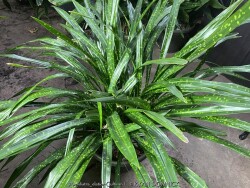

Cast-iron Plant (Aspidistra sp.) is a beautiful perennial and warmer climates for full shade. The leaves are glossy green perched on narrow stems with fat leaf blades. Unfortunately in our zone 6 Kansas climate, they cannot reliably be used as a perennial here. Most broadleaf evergreen plants are difficult to push the envelope with colder zones because evergreen leaves are more expensive to replace than for deciduous plants (slower and requires more energy from the plant). As a potted patio plant for full shade, they are wonderful. Grown in a raised pot, they are hardy to about 20-25° so you may be able to miss the first few frosts when moving them in for the winter. Before extreme cold (lower than approx.15 degrees F), they must be moved and overwintered in a dark garage or basement with monthly watering or bright window as a winter-only houseplant. Either way, they will hold up very well in the winter and maintain attractive foliage. When grown as a permanent house plant, they will last many years is grown in a bright indirect area. When Cast-iron Plant is grown as a permanent houseplant, you will need to watch for spider mites and possibly scale after a few years. Taking the whole plant outside and spraying with water a few times a year will help. Spider mites thrive and dry dusty conditions with low humidity (such as your house). Overall, Cast-iron Plants are very easy to grow hence their name. They will tolerate lower light than just about any house plant but after a few years, even this plant will decline unless given a summer growing season under a shaded tree or brighter conditions inside the house. New leaves grow about once per year and gradually the plant will need to be repotted as it is possible for them to split the container. This is a great time to divide the root system and get several new plants. This is one of our all-time favorite house plants.
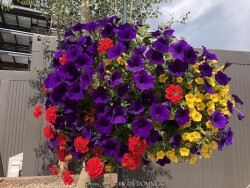

Assorted Annual Flowering Hanging Baskets offer intense color to the patio or pergola!
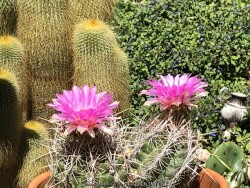

Succulents are usually spineless and grown for their beautiful shapes, color and texture. Cacti are known for their spines, unusual shapes and beautiful flowers. Both succulents and cacti store water in their fleshy tissues. And can survive long periods without water. Cacti and succulents are usually grown as a deck/patio plant or house plant in Kansas. Grow in full sun with little to no extra watering except that which comes from rainfall. Generally, plants may be brought out in Late May through Early October in our zone 6a Lawrence, KS climate. To play is safe, potted plants are best moved in before autumn leaves begin to drop and before night temperatures get below 45 degrees F. It is very important to avoid the combination of wet and cold. Move to a bright interior window over the winter with little to no watering and keep above 50 degrees F. As a winter house plant, it will look presentable all winter long with little to no waterings. As a permanent house plant, provide bright light and allow the soil to dry completely between waterings and you will get many years of carefree enjoyment. Plants grown permanently indoors may eventually begin to elongate stretching for light and lose their spine color. It can be hard to reproduce the intense UV sunlight they need when growing indoors so moving outside for the summer is best. Generally if moving outside for the summer, allow 1-2 weeks of part shade or morning sun before placing in full sun. Plants with time to acclimate will thrive in full sun but be careful not to rush it or sunburning may occur. Repotting may or may not be needed depending on how large you want the plant to grow; plants can continue to grow taller and tolerate extremely root-bound pots but may need wind bracing. If repotting, make sure to use a sharp draining low organic cactus mix with plenty of sand and perlite but avoid peat moss. The “soil” most commercial cacti are potted in to too peaty and light weight. This soil becomes hydrophobic and shrinks after becoming bone dry and difficult to re wet again. Cacti never grow in peat-based soils in nature; this “Soil” is only good for shipping because of the light weight. Potted plants are very low maintenance but watch for scale and mealybugs that may hide beneath the cover of spines. The best pest removal approach is to periodically wash the cactus off. Achieve this with a water nozzle or hose breaker turned mostly off to increase the pressure from the blast of water. This high-pressured water kills the pests without damaging the thick cactus skin. Here are some little-known or rare factoids about cacti: 1. The "spines" are actually modified leaves filled with sap at first, then quickly drying out to form the spines! 2. Many cacti have bright colored flowers that mainly attract bees, while some tubular flowering types attract hummingbirds and bats. 3. Late on the evolutionary timeline, cacti fossils are rare to non-existent. Cacti are native almost exclusively to the Americas, while succulents can include a much larger plant palette be from any dry area in the world. 4. Some cactus plants have been known to survive more than 2 years without water. 5. Some cacti first evolved in a dry climate that later became wetter again. For example: several jungle species live as epiphytes in trees to achieve the fast drainage they need.
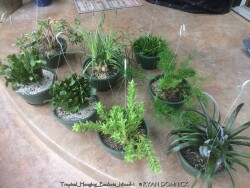

Succulents are usually spineless and grown for their beautiful shapes, color and texture. Cactus are known for their spines, unusual shapes and beautiful flowers. Late on the evolutionary timeline, cacti fossils are rare to non-existent. The "spines" are actually modified leaves! Cacti are native almost exclusively to the Americas, while succulents can include a much larger plant palette be from any dry area in the world. Both succulents and cacti store water in their fleshy tissues. They are usually grown as a patio or house plant in Kansas. In the wild, some species are hardy to below 0 degrees F. Grow in full sun with no extra watering except that which comes from rainfall. Repotting may or may not be needed depending on how large you want the plant to grow; plants can continue to grow taller and tolerate extremely root-bound pots but may need wind bracing. If repotting, make sure to use a sharp draining low organic cactus mix with plenty of sand and perlite. To play is safe, potted plants are best moved in before night temperatures get below 45 degrees F. It is important to avoid the combination of wet and cold. Move to a bright interior window over the winter with no watering and keep above freezing. As a winter house plant, it will look presentable all winter long with just no waterings. As a permanent house plant, provide bright light and allow the soil to dry between waterings for many years of carefree enjoyment. Plants grown permanently indoors may begin to elongate stretching for light and lose their spine color. It can be hard to reproduce the intense UV sunlight they need so moving outside for the summer is best. Generally if moving outside for the summer, allow 1-2 weeks of part shade or morning sun before placing in full sun. Plants with time to acclimate will thrive in full sun but be careful not to rush it or sunburning will occur. Potted plants are very low maintenance but watch for scale and mealybugs that may hide beneath the cover of spines. Some species grow well in hanging baskets!
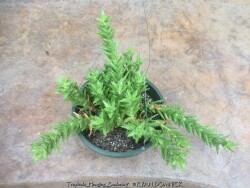

***Description for this plant available with future update!***


***Description for this plant available with future update!*** Cacti are known for their spines, unusual shapes and beautiful flowers. Both succulents and cacti store water in their fleshy tissues. And can survive long periods without water. Cacti and succulents are usually grown as a deck/patio plant or house plant in Kansas. Grow in full sun with little to no extra watering except that which comes from rainfall. Generally, plants may be brought out in Late May through Early October in our zone 6a Lawrence, KS climate. To play is safe, potted plants are best moved in before autumn leaves begin to drop and before night temperatures get below 45 degrees F. It is very important to avoid the combination of wet and cold. Move to a bright interior window over the winter with little to no watering and keep above 50 degrees F. As a winter house plant, it will look presentable all winter long with little to no waterings. As a permanent house plant, provide bright light and allow the soil to dry completely between waterings and you will get many years of carefree enjoyment. Plants grown permanently indoors may eventually begin to elongate stretching for light and lose their spine color. It can be hard to reproduce the intense UV sunlight they need when growing indoors so moving outside for the summer is best. Generally if moving outside for the summer, allow 1-2 weeks of part shade or morning sun before placing in full sun. Plants with time to acclimate will thrive in full sun but be careful not to rush it or sunburning may occur. Repotting may or may not be needed depending on how large you want the plant to grow; plants can continue to grow taller and tolerate extremely root-bound pots but may need wind bracing. If repotting, make sure to use a sharp draining low organic cactus mix with plenty of sand and perlite but avoid peat moss. The “soil” most commercial cacti are potted in to too peaty and light weight. This soil becomes hydrophobic and shrinks after becoming bone dry and difficult to re wet again. Cacti never grow in peat-based soils in nature; this “Soil” is only good for shipping because of the light weight. Potted plants are very low maintenance but watch for scale and mealybugs that may hide beneath the cover of spines. The best pest removal approach is to periodically wash the cactus off. Achieve this with a water nozzle or hose breaker turned mostly off to increase the pressure from the blast of water. This high-pressured water kills the pests without damaging the thick cactus skin. Here are some little-known or rare factoids about cacti: 1. The "spines" are actually modified leaves filled with sap at first, then quickly drying out to form the spines! 2. Many cacti have bright colored flowers that mainly attract bees, while some tubular flowering types attract hummingbirds and bats. 3. Late on the evolutionary timeline, cacti fossils are rare to non-existent. Cacti are native almost exclusively to the Americas, while succulents can include a much larger plant palette be from any dry area in the world. 4. Some cactus plants have been known to survive more than 2 years without water. 5. Some cacti first evolved in a dry climate that later became wetter again. For example: several jungle species live as epiphytes in trees to achieve the fast drainage they need.
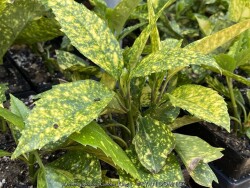

Japanese Aucuba (Aucuba japonica) is a surprisingly hardy evergreen shrub from Japan featuring dark green leaves with gold spots. Flowering and fruiting may occur in warmer climates but have not witnessed that in our zone 6a climate. Aucuba is at the northern edge of its range but will survive and reach varying heights of 1 to 3 feet. Winterkill occurs at about -5 to -10° so plan to prune off winter kill and new growth will resume in spring. In southern zones with mild winters aucuba can reach 6-8' tall, tolerating full shade and drought making it a great dry shade plant. In our Lawrence Gardens, this is possible if sited on a south exposure in full shade with winter wind protection. Rich organic soils and morning sun / filtered sun are both preferred in northern climates. Watering during the winter when dry will help broadleaf evergreen shrubs stay hydrated and maintain their winter foliage better. This jewel of the shade garden adds valuable bright green and yellow winter color giving some structure. Combine with other shade plants such as hosta, Solomon Seal, Hellebore, Barrenwort, or Coralberry. Plants in our Lawrence, KS gardens generally survive for several years and are worth the effort in the shade garden. Don't count on them getting very big so plant close together if designing with a grouping. Aucuba japonica 'Gold King' is a male form with numerous gold spots on dark green leaves.


The False Indigo species (Baptisia) features beautiful compact bluish green leaves arranged in groups of three. Like many members in the legume family, they are nitrogen fixing plants which means they produce their own nitrogen in the soil through a symbiotic relationship with bacteria. The flowers bloom above the foliage normally in April and May. Common baptisia flower colors include white, purple, lavender, yellow, and pink as well as uncommon colors ranging from deep purple to maroon and even coppery orange. Considered a great North American native three season plant, the foliage always emerges very attractive followed by flowers that do not need deadheading. Foliage generally lasts pretty nice through hot summers and into fall turning black with first freeze. Seed pods also turn charcoal black when ripe and have considerable ornamental interest and useful in dried flower arrangements. At some point in the fall, it can be cut down early for a clean look or left for winter interest. Baptisia generally do well in droughty clay soils in full to part sun. There is only one pest that may create problems called the Genista Broom Moth. It may occur in Kansas when weather conditions are consistently dry and over 95 degrees F. It is treatable if you act fast but if not, it only destroys the foliage late in the season and does not kill the plant. Baptisia has several enormous spreading taproots which store water and energy and can make transplanting difficult. Plantings look good as specimen or in small groups; and it's ok even preferable if they grow together and touch other plants. That helps eliminate available sunlight and discourages weeds. It is hard to picture a native plant garden or any perennial garden without Baptisia. Considered a once "it's there, it's always there" plant. Baptisia 'American Goldfinch' >>>>>>>Gorgeous, golden yellow flower spikes rise up above its wide habit. This is one of the most floriferous Baptisia we offer, producing loads of brightly colored spikes for many weeks. After the blooming season, 'American Goldfinch' produces attractive round seed pods in the fall. This is the perfect specimen for filling in a large space in your garden or for mass plantings in landscapes. >>>>> This extremely long-lived perennial could be used instead of a shrub in landscape settings, with minimal care required to thrive year after year.
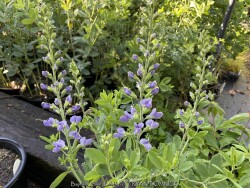

The False Indigo species (Baptisia) features beautiful compact bluish green leaves arranged in groups of three. Like many members in the legume family, they are nitrogen fixing plants which means they produce their own nitrogen in the soil through a symbiotic relationship with bacteria. The flowers bloom above the foliage normally in April and May. Common baptisia flower colors include white, purple, lavender, yellow, and pink as well as uncommon colors ranging from deep purple to maroon and even coppery orange. Considered a great North American native three season plant, the foliage always emerges very attractive followed by flowers that do not need deadheading. Foliage generally lasts pretty nice through hot summers and into fall turning black with first freeze. Seed pods also turn charcoal black when ripe and have considerable ornamental interest and useful in dried flower arrangements. At some point in the fall, it can be cut down early for a clean look or left for winter interest. Baptisia generally do well in droughty clay soils in full to part sun. There is only one pest that may create problems called the Genista Broom Moth. It may occur in Kansas when weather conditions are consistently dry and over 95 degrees F. It is treatable if you act fast but if not, it only destroys the foliage late in the season and does not kill the plant. Baptisia has several enormous spreading taproots which store water and energy and can make transplanting difficult. Plantings look good as specimen or in small groups; and it's ok even preferable if they grow together and touch other plants. That helps eliminate available sunlight and discourages weeds. It is hard to picture a native plant garden or any perennial garden without Baptisia. Considered a once "it's there, it's always there" long lived plant. Baptisia 'Blue Bubbly' is a lavender-blue flowering tall variety. Its vase-like habit is topped with densely packed, blue flowers. The long, 16" flower spikes make for an extended season of bloom. This extremely long-lived perennial could be used instead of a shrub in landscape settings, with minimal care required to thrive year after year. This plant is a member of the DECADENCE® DELUXE series from Walters Gardens, Inc.
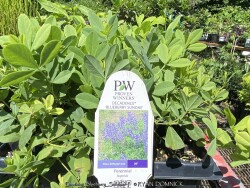

The False Indigo species (Baptisia) features beautiful compact bluish green leaves arranged in groups of three. Like many members in the legume family, they are nitrogen fixing plants which means they produce their own nitrogen in the soil through a symbiotic relationship with bacteria. The flowers bloom above the foliage normally in April and May. Common baptisia flower colors include white, purple, lavender, yellow, and pink as well as uncommon colors ranging from deep purple to maroon and even coppery orange. Considered a great North American native three season plant, the foliage always emerges very attractive followed by flowers that do not need deadheading. Foliage generally lasts pretty nice through hot summers and into fall turning black with first freeze. Seed pods also turn charcoal black when ripe and have considerable ornamental interest and useful in dried flower arrangements. At some point in the fall, it can be cut down early for a clean look or left for winter interest. Baptisia generally do well in droughty clay soils in full to part sun. There is only one pest that may create problems called the Genista Broom Moth. It may occur in Kansas when weather conditions are consistently dry and over 95 degrees F. It is treatable if you act fast but if not, it only destroys the foliage late in the season and does not kill the plant. Baptisia has several enormous spreading taproots which store water and energy and can make transplanting difficult. Plantings look good as specimen or in small groups; and it's ok even preferable if they grow together and touch other plants. That helps eliminate available sunlight and discourages weeds. It is hard to picture a native plant garden or any perennial garden without Baptisia. Considered a once "it's there, it's always there" long lived plant. Baptisia 'Blueberry Sundae' features deep indigo blue flowers much more vibrant than the original species B. australis. The deep blue-green foliage forms a more compact, upright mound to 3' tall at maturity. 'Blueberry Sundae' is a vigorous grower and the foliage looks great all summer. Ornamental seed pods extend the season of interest into fall. This plant is a member of the DECADENCE® series from Walters Gardens, Inc.
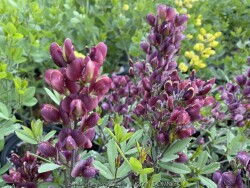

The False Indigo species (Baptisia) features beautiful compact bluish green leaves arranged in groups of three. Like many members in the legume family, they are nitrogen fixing plants which means they produce their own nitrogen in the soil through a symbiotic relationship with bacteria. The flowers bloom above the foliage normally in April and May. Common baptisia flower colors include white, purple, lavender, yellow, and pink as well as uncommon colors ranging from deep purple to maroon and even coppery orange. Considered a great North American native three season plant, the foliage always emerges very attractive followed by flowers that do not need deadheading. Foliage generally lasts pretty nice through hot summers and into fall turning black with first freeze. Seed pods also turn charcoal black when ripe and have considerable ornamental interest and useful in dried flower arrangements. At some point in the fall, it can be cut down early for a clean look or left for winter interest. Baptisia generally do well in droughty clay soils in full to part sun. There is only one pest that may create problems called the Genista Broom Moth. It may occur in Kansas when weather conditions are consistently dry and over 95 degrees F. It is treatable if you act fast but if not, it only destroys the foliage late in the season and does not kill the plant. Baptisia has several enormous spreading taproots which store water and energy and can make transplanting difficult. Plantings look good as specimen or in small groups; and it's ok even preferable if they grow together and touch other plants. That helps eliminate available sunlight and discourages weeds. It is hard to picture a native plant garden or any perennial garden without Baptisia. Considered a once "it's there, it's always there" plant. >>>>>Baptisia 'Burgundy Blast' features dark wine purple flowers are produced over very dark blue-green foliage. When it is in bloom, it is a stunning display of color. This extremely long-lived perennial could be used instead of a shrub in landscape settings, with minimal care required to thrive year after year.


The False Indigo species (Baptisia) features beautiful compact bluish green leaves arranged in groups of three. Like many members in the legume family, they are nitrogen fixing plants which means they produce their own nitrogen in the soil through a symbiotic relationship with bacteria. The flowers bloom above the foliage normally in April and May. Common baptisia flower colors include white, purple, lavender, yellow, and pink as well as uncommon colors ranging from deep purple to maroon and even coppery orange. Considered a great North American native three season plant, the foliage always emerges very attractive followed by flowers that do not need deadheading. Foliage generally lasts pretty nice through hot summers and into fall turning black with first freeze. Seed pods also turn charcoal black when ripe and have considerable ornamental interest and useful in dried flower arrangements. At some point in the fall, it can be cut down early for a clean look or left for winter interest. Baptisia generally do well in droughty clay soils in full to part sun. There is only one pest that may create problems called the Genista Broom Moth. It may occur in Kansas when weather conditions are consistently dry and over 95 degrees F. It is treatable if you act fast but if not, it only destroys the foliage late in the season and does not kill the plant. Baptisia has several enormous spreading taproots which store water and energy and can make transplanting difficult. Plantings look good as specimen or in small groups; and it's ok even preferable if they grow together and touch other plants. That helps eliminate available sunlight and discourages weeds. It is hard to picture a native plant garden or any perennial garden without Baptisia. Considered a once "it's there, it's always there" long lived plant. >>>>>Baptisia 'Cherries Jubilee' features deep maroon buds open to bicolor maroon and yellow flowers held on strong scapes above the blue-green foliage in late spring to early summer. Secondary branching on the flower stems makes this variety especially floriferous. As the flowers age, they turn gold creating the bi-color effect! This extremely long-lived perennial could be used instead of a shrub in landscape settings, with minimal care required to thrive year after year.>>>>>This plant is a member of the DECADENCE® series from Walters Gardens, Inc.
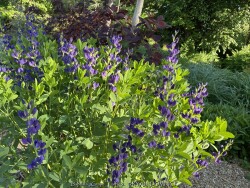

The False Indigo species (Baptisia) features beautiful compact bluish green leaves arranged in groups of three. Like many members in the legume family, they are nitrogen fixing plants which means they produce their own nitrogen in the soil through a symbiotic relationship with bacteria. The flowers bloom above the foliage normally in April and May. Common baptisia flower colors include white, purple, lavender, yellow, and pink as well as uncommon colors ranging from deep purple to maroon and even coppery orange. Considered a great North American native three season plant, the foliage always emerges very attractive followed by flowers that do not need deadheading. Foliage generally lasts pretty nice through hot summers and into fall turning black with first freeze. Seed pods also turn charcoal black when ripe and have considerable ornamental interest and useful in dried flower arrangements. At some point in the fall, it can be cut down early for a clean look or left for winter interest. Baptisia generally do well in droughty clay soils in full to part sun. There is only one pest that may create problems called the Genista Broom Moth. It may occur in Kansas when weather conditions are consistently dry and over 95 degrees F. It is treatable if you act fast but if not, it only destroys the foliage late in the season and does not kill the plant. Baptisia has several enormous spreading taproots which store water and energy and can make transplanting difficult. Plantings look good as specimen or in small groups; and it's ok even preferable if they grow together and touch other plants. That helps eliminate available sunlight and discourages weeds. It is hard to picture a native plant garden or any perennial garden without Baptisia. Considered a once "it's there, it's always there" plant. Baptisia 'Grape Taffy' is a compact cultivar from the Walters Gardens, Inc. reaching only 2-3' tall. This color break-thru features spikes of deep reddish-purple flowers appear in early summer, reminiscent of grapes. The foliage of Grape Taffy, more green compared to other varieties, looks attractive even when the flowers are not in bloom. This extremely long-lived perennial could be used instead of a shrub in landscape settings, with minimal care required to thrive year after year.
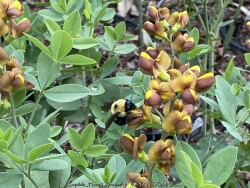

The False Indigo species (Baptisia) features beautiful compact bluish green leaves arranged in groups of three. Like many members in the legume family, they are nitrogen fixing plants which means they produce their own nitrogen in the soil through a symbiotic relationship with bacteria. The flowers bloom above the foliage normally in April and May. Common baptisia flower colors include white, purple, lavender, yellow, and pink as well as uncommon colors ranging from deep purple to maroon and even coppery orange. Considered a great North American native three season plant, the foliage always emerges very attractive followed by flowers that do not need deadheading. Foliage generally lasts pretty nice through hot summers and into fall turning black with first freeze. Seed pods also turn charcoal black when ripe and have considerable ornamental interest and useful in dried flower arrangements. At some point in the fall, it can be cut down early for a clean look or left for winter interest. Baptisia generally do well in droughty clay soils in full to part sun. There is only one pest that may create problems called the Genista Broom Moth. It may occur in Kansas when weather conditions are consistently dry and over 95 degrees F. It is treatable if you act fast but if not, it only destroys the foliage late in the season and does not kill the plant. Baptisia has several enormous spreading taproots which store water and energy and can make transplanting difficult. Plantings look good as specimen or in small groups; and it's ok even preferable if they grow together and touch other plants. That helps eliminate available sunlight and discourages weeds. It is hard to picture a native plant garden or any perennial garden without Baptisia. Considered a once "it's there, it's always there" long lived plant. Baptisia 'Honey Roasted' features long 10" spikes of dark mahogany flowers have bright yellow keels, producing a wonderful bicolor effect. The bushy habit is jam-packed with flowers when it is in bloom early in the growing season. Flowers lighten to yellow as the flowers mature. This extremely long-lived perennial could be used instead of a shrub in landscape settings, with minimal care required to thrive year after year.
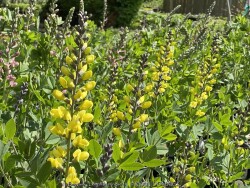

The False Indigo species (Baptisia) features beautiful compact bluish green leaves arranged in groups of three. Like many members in the legume family, they are nitrogen fixing plants which means they produce their own nitrogen in the soil through a symbiotic relationship with bacteria. The flowers bloom above the foliage normally in April and May. Common baptisia flower colors include white, purple, lavender, yellow, and pink as well as uncommon colors ranging from deep purple to maroon and even coppery orange. Considered a great North American native three season plant, the foliage always emerges very attractive followed by flowers that do not need deadheading. Foliage generally lasts pretty nice through hot summers and into fall turning black with first freeze. Seed pods also turn charcoal black when ripe and have considerable ornamental interest and useful in dried flower arrangements. At some point in the fall, it can be cut down early for a clean look or left for winter interest. Baptisia generally do well in droughty clay soils in full to part sun. There is only one pest that may create problems called the Genista Broom Moth. It may occur in Kansas when weather conditions are consistently dry and over 95 degrees F. It is treatable if you act fast but if not, it only destroys the foliage late in the season and does not kill the plant. Baptisia has several enormous spreading taproots which store water and energy and can make transplanting difficult. Plantings look good as specimen or in small groups; and it's ok even preferable if they grow together and touch other plants. That helps eliminate available sunlight and discourages weeds. It is hard to picture a native plant garden or any perennial garden without Baptisia. Considered a once "it's there, it's always there" long lived plant. Baptisia 'Lemon Meringue' is an excellent vigorous yellow flowered selection. It forms an upright, vase-shaped mound of attractive blue-green foliage topped with long, charcoal stems which carry the lemon yellow flowers in late spring to early summer. The contrast of dark stems with light flowers really pops in the landscape, delivering an excellent floral display. Ornamental seed pods extend the season of interest into fall. This extremely long-lived perennial could be used instead of a shrub in landscape settings, with minimal care required to thrive year after year. This plant is a member of the DECADENCE® series from Walters Gardens, Inc.
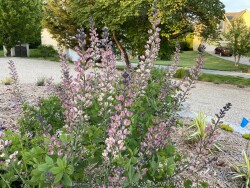

The False Indigo species (Baptisia) features beautiful compact bluish green leaves arranged in groups of three. Like many members in the legume family, they are nitrogen fixing plants which means they produce their own nitrogen in the soil through a symbiotic relationship with bacteria. The flowers bloom above the foliage normally in April and May. Common baptisia flower colors include white, purple, lavender, yellow, and pink as well as uncommon colors ranging from deep purple to maroon and even coppery orange. Considered a great North American native three season plant, the foliage always emerges very attractive followed by flowers that do not need deadheading. Foliage generally lasts pretty nice through hot summers and into fall turning black with first freeze. Seed pods also turn charcoal black when ripe and have considerable ornamental interest and useful in dried flower arrangements. At some point in the fall, it can be cut down early for a clean look or left for winter interest. Baptisia generally do well in droughty clay soils in full to part sun. There is only one pest that may create problems called the Genista Broom Moth. It may occur in Kansas when weather conditions are consistently dry and over 95 degrees F. It is treatable if you act fast but if not, it only destroys the foliage late in the season and does not kill the plant. Baptisia has several enormous spreading taproots which store water and energy and can make transplanting difficult. Plantings look good as specimen or in small groups; and it's ok even preferable if they grow together and touch other plants. That helps eliminate available sunlight and discourages weeds. It is hard to picture a native plant garden or any perennial garden without Baptisia. Considered a once "it's there, it's always there" long lived plant. Baptisia 'Pink Truffles' is an excellent vigorous pink flowered selection; quite a color break-thru for Baptisia! Clear soft pink blossoms with a pale yellow keel are produced in late spring on bright green foliage. Its compact, shorter habit makes it easy to fit into any garden. This extremely long-lived perennial could be used instead of a shrub in landscape settings, with minimal care required to thrive year after year. This plant is a member of the DECADENCE® series from Walters Gardens, Inc.
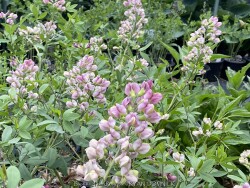

The False Indigo species (Baptisia) features beautiful compact bluish green leaves arranged in groups of three. Like many members in the legume family, they are nitrogen fixing plants which means they produce their own nitrogen in the soil through a symbiotic relationship with bacteria. The flowers bloom above the foliage normally in April and May. Common baptisia flower colors include white, purple, lavender, yellow, and pink as well as uncommon colors ranging from deep purple to maroon and even coppery orange. Considered a great North American native three season plant, the foliage always emerges very attractive followed by flowers that do not need deadheading. Foliage generally lasts pretty nice through hot summers and into fall turning black with first freeze. Seed pods also turn charcoal black when ripe and have considerable ornamental interest and useful in dried flower arrangements. At some point in the fall, it can be cut down early for a clean look or left for winter interest. Baptisia generally do well in droughty clay soils in full to part sun. There is only one pest that may create problems called the Genista Broom Moth. It may occur in Kansas when weather conditions are consistently dry and over 95 degrees F. It is treatable if you act fast but if not, it only destroys the foliage late in the season and does not kill the plant. Baptisia has several enormous spreading taproots which store water and energy and can make transplanting difficult. Plantings look good as specimen or in small groups; and it's ok even preferable if they grow together and touch other plants. That helps eliminate available sunlight and discourages weeds. It is hard to picture a native plant garden or any perennial garden without Baptisia. Considered a once "it's there, it's always there" long lived plant. Baptisia 'Plum Rosy' is an excellent vigorous pink and white flowered selection; quite a color break-thru for Baptisia! Pink blossoms age to white creating a bi-colored effect in late spring on bright green foliage. This full-size but dense habit can work like a shrub in any garden. This extremely long-lived perennial could be used instead of a shrub in landscape settings, with minimal care required to thrive year after year. This plant was introduced from Walters Gardens, Inc.


The False Indigo species (Baptisia) features beautiful compact bluish green leaves arranged in groups of three. Like many members in the legume family, they are nitrogen fixing plants which means they produce their own nitrogen in the soil through a symbiotic relationship with bacteria. The flowers bloom above the foliage normally in April and May. Common baptisia flower colors include white, purple, lavender, yellow, and pink as well as uncommon colors ranging from deep purple to maroon and even coppery orange. Considered a great North American native three season plant, the foliage always emerges very attractive followed by flowers that do not need deadheading. Foliage generally lasts pretty nice through hot summers and into fall turning black with first freeze. Seed pods also turn charcoal black when ripe and have considerable ornamental interest and useful in dried flower arrangements. At some point in the fall, it can be cut down early for a clean look or left for winter interest. Baptisia generally do well in droughty clay soils in full to part sun. There is only one pest that may create problems called the Genista Broom Moth. It may occur in Kansas when weather conditions are consistently dry and over 95 degrees F. It is treatable if you act fast but if not, it only destroys the foliage late in the season and does not kill the plant. Baptisia has several enormous spreading taproots which store water and energy and can make transplanting difficult. Plantings look good as specimen or in small groups; and it's ok even preferable if they grow together and touch other plants. That helps eliminate available sunlight and discourages weeds. It is hard to picture a native plant garden or any perennial garden without Baptisia. Considered a once "it's there, it's always there" plant. According to Walters Gardens, Baptisia 'Violet Dusk' features "lavender violet flowers with cream keels makes this a stunning display for the early season garden. Its claim to fame is its unique vase-like habit. Although this plant is 3' wide, the base of the plant takes up a relatively small footprint, leaving space to under plant with other perennials. In comparison to other Baptisia in our trials, 'Violet Dusk' is relatively late to bloom." This extremely long-lived perennial could be used instead of a shrub in landscape settings, with minimal care required to thrive year after year.
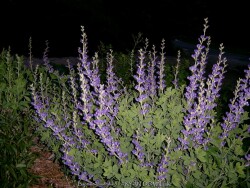

False Indigo (Baptisia australis) features beautiful compact bluish green leaves arranged in groups of three. Like many members in the legume family, they are nitrogen fixing plants which means they produce their own nitrogen in the soil through a symbiotic relationship with bacteria. The flowers bloom above the foliage normally in April and May. Common baptisia flower colors include white, purple, lavender, yellow, and pink as well as uncommon colors ranging from deep purple to maroon and even coppery orange. Considered a great North American native three season plant, the foliage always emerges very attractive followed by flowers that do not need deadheading. Foliage generally lasts pretty nice through hot summers and into fall turning black with first freeze. Seed pods also turn charcoal black when ripe and have considerable ornamental interest and useful in dried flower arrangements. At some point in the fall, it can be cut down early for a clean look or left for winter interest. Baptisia generally do well in droughty clay soils in full to part sun. There is only one pest that may create problems called the Genista Broom Moth. It may occur in Kansas when weather conditions are consistently dry and over 95 degrees F. It is treatable if you act fast but if not, it only destroys the foliage late in the season and does not kill the plant. Baptisia has several enormous spreading taproots which store water and energy and can make transplanting difficult. Plantings look good as specimen or in small groups; and it's ok even preferable if they grow together and touch other plants. That helps eliminate available sunlight and discourages weeds. It is hard to picture a native plant garden or any perennial garden without Baptisia. Considered a once "it's there, it's always there" plant.
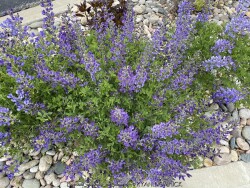

False Indigo features beautiful compact bluish green leaves arranged in groups of three. Like many members in the legume family, they are nitrogen fixing plants which means they produce their own nitrogen in the soil through a symbiotic relationship with bacteria. The flowers bloom above the foliage normally in April and May. Common baptisia flower colors include white, purple, lavender, yellow, and pink as well as uncommon colors ranging from deep purple to maroon and even coppery orange. Considered a great North American native three season plant, the foliage always emerges very attractive followed by flowers that do not need deadheading. Foliage generally lasts pretty nice through hot summers and into fall turning black with first freeze. Seed pods also turn charcoal black when ripe and have considerable ornamental interest and useful in dried flower arrangements. At some point in the fall, it can be cut down early for a clean look or left for winter interest. Baptisia generally do well in droughty clay soils in full to part sun. There is only one pest that may create problems called the Genista Broom Moth. It may occur in Kansas when weather conditions are consistently dry and over 95 degrees F. It is treatable if you act fast but if not, it only destroys the foliage late in the season and does not kill the plant. Baptisia has several enormous spreading taproots which store water and energy and can make transplanting difficult. Plantings look good as specimen or in small groups; and it's ok even preferable if they grow together and touch other plants. That helps eliminate available sunlight and discourages weeds. It is hard to picture a native plant garden or any perennial garden without Baptisia. Considered a once "it's there, it's always there" plant. Baptisia australis var. minor has a shorter and more compact stature, being native to drier Western areas compared to the species. This includes Central and Eastern Kansas, Oklahoma, Texas, and Nebraska.
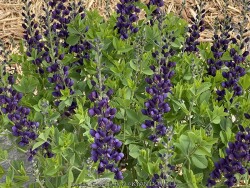

False Indigo (Baptisia) features beautiful compact bluish green leaves arranged in groups of three. Like many members in the legume family, they are nitrogen fixing plants which means they produce their own nitrogen in the soil through a symbiotic relationship with bacteria. The flowers bloom above the foliage normally in April and May. Common baptisia flower colors include white, purple, lavender, yellow, and pink as well as uncommon colors ranging from deep purple to maroon and even coppery orange. Considered a great North American native three season plant, the foliage always emerges very attractive followed by flowers that do not need deadheading. Foliage generally lasts pretty nice through hot summers and into fall turning black with first freeze. Seed pods also turn charcoal black when ripe and have considerable ornamental interest and useful in dried flower arrangements. At some point in the fall, it can be cut down early for a clean look or left for winter interest. Baptisia generally do well in droughty clay soils in full to part sun. There is only one pest that may create problems called the Genista Broom Moth. It may occur in Kansas when weather conditions are consistently dry and over 95 degrees F. It is treatable if you act fast but if not, it only destroys the foliage late in the season and does not kill the plant. Baptisia has several enormous spreading taproots which store water and energy and can make transplanting difficult. Plantings look good as specimen or in small groups; and it's ok even preferable if they grow together and touch other plants. That helps eliminate available sunlight and discourages weeds. It is hard to picture a native plant garden or any perennial garden without Baptisia. Considered a once "it's there, it's always there" plant. Many different cultivars and flower colors are available.
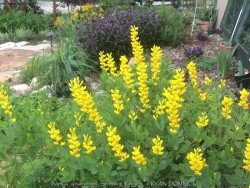

The False Indigo (Baptisia species) features beautiful compact bluish green leaves arranged in groups of three. Like many members in the legume family, they are nitrogen fixing plants which means they produce their own nitrogen in the soil through a symbiotic relationship with bacteria. The flowers bloom above the foliage normally in April and May. Common baptisia flower colors include white, purple, lavender, yellow, and pink as well as uncommon colors ranging from deep purple to maroon and even coppery orange. Considered a great North American native three season plant, the foliage always emerges very attractive followed by flowers that do not need deadheading. Foliage generally lasts pretty nice through hot summers and into fall turning black with first freeze. Seed pods also turn charcoal black when ripe and have considerable ornamental interest and useful in dried flower arrangements. At some point in the fall, it can be cut down early for a clean look or left for winter interest. Baptisia generally do well in droughty clay soils in full to part sun. There is only one pest that may create problems called the Genista Broom Moth. It may occur in Kansas when weather conditions are consistently dry and over 95 degrees F. It is treatable if you act fast but if not, it only destroys the foliage late in the season and does not kill the plant. Baptisia has several enormous spreading taproots which store water and energy and can make transplanting difficult. Plantings look good as specimen or in small groups; and it's ok even preferable if they grow together and touch other plants. That helps eliminate available sunlight and discourages weeds. It is hard to picture a native plant garden or any perennial garden without Baptisia. Considered a once "it's there, it's always there" plant. Baptisia sphaerocarpa 'Screaming Yellow' is one of the best yellows, featuring bright golden yellow flowers and more rounded seed pods.
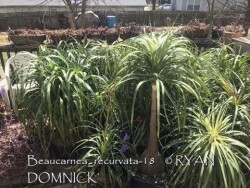

Ponytail Palm / Elephant's Foot (Beaucarnea recurvata) has a pronounced swollen caudex (trunk) and attractive green grass-like curved foliage making an excellent architectural statement. Ponytail Palm (not a true palm) is native to low deciduous forests and semi-desert areas of southeastern Mexico, Belize and Guatemala where it typically grows to as much as 30' tall. It is best used as a houseplant or summer patio plant in Kansas. Place in full sun to part sun with optional extra watering including that which comes from rainfall. Repotting may or may not be needed depending on how large you want the plant to grow; plants can continue to grow taller and tolerate extremely root-bound pots but may need wind bracing. in Potted plants are hardy to at least 25 degrees F for a short time if kept dry so you are ok if you miss the first light frost. Do not allow the pot with rootball to freeze solid though. Move into a cold garage, basement, or bright window over the winter with occasional to no watering. Larger ponytail palms can survive 6-8 months without water in the winter if allowed to have a healthy outdoor growing season. As a winter house plant, it will look presentable all winter long with just a couple waterings.(also to prevent lanky winter growth) As a permanent house plant, provide bright light and allow the soil to dry between waterings for many years (even decades) of carefree enjoyment. Potted plants grow very slow and are very low maintenance needing only old leaves trimmed once per year. Mealy bugs can be a problem with permanent indoor house plants but will go away if grown outside during the summer or never introduced in the first place. Either way, sharp blasts of hose water and/or horticultural oil spray will mostly eliminate this (only) pest problem.


Ponytail Palm / Elephant's Foot (Beaucarnea recurvata) has a pronounced swollen caudex (trunk) and attractive green grass-like curved foliage making an excellent architectural statement. Ponytail Palm (not a true palm) is native to low deciduous forests and semi-desert areas of southeastern Mexico, Belize and Guatemala where it typically grows to as much as 30' tall. It is best used as a houseplant or summer patio plant in Kansas. Place in full sun to part sun with optional extra watering including that which comes from rainfall. Repotting may or may not be needed depending on how large you want the plant to grow; plants can continue to grow taller and tolerate extremely root-bound pots but may need wind bracing. in Potted plants are hardy to at least 25 degrees F for a short time if kept dry so you are ok if you miss the first light frost. Do not allow the pot with rootball to freeze solid though. Move into a cold garage, basement, or bright window over the winter with occasional to no watering. Larger ponytail palms can survive 6-8 months without water in the winter if allowed to have a healthy outdoor growing season. As a winter house plant, it will look presentable all winter long with just a couple waterings.(also to prevent lanky winter growth) As a permanent house plant, provide bright light and allow the soil to dry between waterings for many years (even decades) of carefree enjoyment. Potted plants grow very slow and are very low maintenance needing only old leaves trimmed once per year. Mealy bugs can be a problem with permanent indoor house plants but will go away if grown outside during the summer or never introduced in the first place. Either way, sharp blasts of hose water and/or horticultural oil spray will mostly eliminate this (only) pest problem.
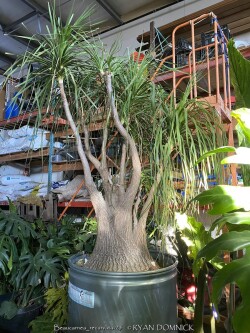

Ponytail Palm / Elephant's Foot (Beaucarnea recurvata) has a pronounced swollen caudex (trunk) and attractive green grass-like curved foliage making an excellent architectural statement. Ponytail Palm (not a true palm) is native to low deciduous forests and semi-desert areas of southeastern Mexico, Belize and Guatemala where it typically grows to as much as 30' tall. It is best used as a houseplant or summer patio plant in Kansas. Place in full sun to part sun with optional extra watering including that which comes from rainfall. Repotting may or may not be needed depending on how large you want the plant to grow; plants can continue to grow taller and tolerate extremely root-bound pots but may need wind bracing. in Potted plants are hardy to at least 25 degrees F for a short time if kept dry so you are ok if you miss the first light frost. Do not allow the pot with rootball to freeze solid though. Move into a cold garage, basement, or bright window over the winter with occasional to no watering. Larger ponytail palms can survive 6-8 months without water in the winter if allowed to have a healthy outdoor growing season. As a winter house plant, it will look presentable all winter long with just a couple waterings.(also to prevent lanky winter growth) As a permanent house plant, provide bright light and allow the soil to dry between waterings for many years (even decades) of carefree enjoyment. Potted plants grow very slow and are very low maintenance needing only old leaves trimmed once per year. Mealy bugs can be a problem with permanent indoor house plants but will go away if grown outside during the summer or never introduced in the first place. Either way, sharp blasts of hose water and/or horticultural oil spray will mostly eliminate this (only) pest problem.
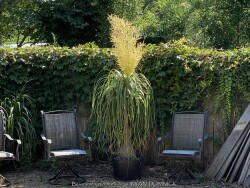

Ponytail Palm / Elephant's Foot (Beaucarnea recurvata) has a pronounced swollen caudex (trunk) and attractive green grass-like curved foliage making an excellent architectural statement. Ponytail Palm (not a true palm) is native to low deciduous forests and semi-desert areas of southeastern Mexico, Belize and Guatemala where it typically grows to as much as 30' tall. It is best used as a houseplant or summer patio plant in Kansas. Place in full sun to part sun with optional extra watering including that which comes from rainfall. Repotting may or may not be needed depending on how large you want the plant to grow; plants can continue to grow taller and tolerate extremely root-bound pots but may need wind bracing. in Potted plants are hardy to at least 25 degrees F for a short time if kept dry so you are ok if you miss the first light frost. Do not allow the pot with rootball to freeze solid though. Move into a cold garage, basement, or bright window over the winter with occasional to no watering. Larger ponytail palms can survive 6-8 months without water in the winter if allowed to have a healthy outdoor growing season. As a winter house plant, it will look presentable all winter long with just a couple waterings.(also to prevent lanky winter growth) As a permanent house plant, provide bright light and allow the soil to dry between waterings for many years (even decades) of carefree enjoyment. Potted plants grow very slow and are very low maintenance needing only old leaves trimmed once per year. Mealy bugs can be a problem with permanent indoor house plants but will go away if grown outside during the summer or never introduced in the first place. Either way, sharp blasts of hose water and/or horticultural oil spray will mostly eliminate this (only) pest problem.


Ponytail Palm / Elephant's Foot (Beaucarnea recurvata) has a pronounced swollen caudex (trunk) and attractive green grass-like curved foliage making an excellent architectural statement. Ponytail Palm (not a true palm) is native to low deciduous forests and semi-desert areas of southeastern Mexico, Belize and Guatemala where it typically grows to as much as 30' tall. It is best used as a houseplant or summer patio plant in Kansas. Place in full sun to part sun with optional extra watering including that which comes from rainfall. Repotting may or may not be needed depending on how large you want the plant to grow; plants can continue to grow taller and tolerate extremely root-bound pots but may need wind bracing. in Potted plants are hardy to at least 25 degrees F for a short time if kept dry so you are ok if you miss the first light frost. Do not allow the pot with rootball to freeze solid though. Move into a cold garage, basement, or bright window over the winter with occasional to no watering. Larger ponytail palms can survive 6-8 months without water in the winter if allowed to have a healthy outdoor growing season. As a winter house plant, it will look presentable all winter long with just a couple waterings.(also to prevent lanky winter growth) As a permanent house plant, provide bright light and allow the soil to dry between waterings for many years (even decades) of carefree enjoyment. Potted plants grow very slow and are very low maintenance needing only old leaves trimmed once per year. Mealy bugs can be a problem with permanent indoor house plants but will go away if grown outside during the summer or never introduced in the first place. Either way, sharp blasts of hose water and/or horticultural oil spray will mostly eliminate this (only) pest problem.
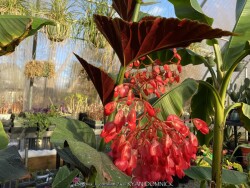

***Description for this plant available with future update!***Angel Wing Begonia (Tropical), is also known as Begonia x coralline
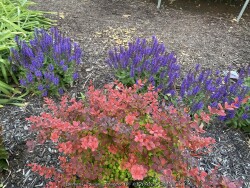

Bright and cheery, this new barberry (Berberis 'Sunjoy Tangelo') has vivid orange new growth that develops a distinctive chartreuse margin as the season goes on. Sunjoy® Tangelo Barberry is stronger growing than other variegated cultivars, it is colorful in the landscape from spring to fall. Certified wheat-rust resistant. Maintenance Notes: Prefers well-drained soils. May be pruned to shape in summer. In Eastern Kansas, this cultivar performs WELL with just about everything nature has to challenge it! Heat and drought are tolerated well. Cold tolerance is no problem. No disease or pest problems. Great plant for berms in full sun. No other plant can match its bright orange-red foliage: I personally love the combination of planting next to blue or purple flowers but the combinations are endless! All Proven Winners® plants are legally propagated, healthy and vigorous, true to name, and tagged with color pictures and growing information.


Crossvine (Bignonia capreolata) is a highly ornamented evergreen vine native to the southeast west to Oklahoma and Texas. Fantastic blooms completely cover the plant and occur on old wood in the late spring for about 3-5 weeks then sporadically during the summer. Flowers are trumpet-shaped, orange and red with yellow throats. Although in the same family as trumpet vine (campus radicans), crossvine is not invasive. Plant crossvine on fences or pergolas where you want good coverage but not anything sprawling too far away from the structure needing pruning. Considered to be one of the lowest maintenance of all vines. Crossvine prefer for part to full sun on in medium to rich soils and are able to tolerate drought and brief flooding once established. There are no serious pests or diseases to worry about. Crossvine has thrived in our Lawrence Kansas zone 6a display garden for over 15 years enduring a few occasions of -10° or colder winters. Winter foliage turns purple and remains evergreen till about -10. We have seen -18° without any dieback on the vine other than the loss of foliage that year. This great vine has it all, beautiful flowers, evergreen foliage, and constrained growth habit! Dressed To Thrill Crossvine (Bignonia capreolata 'Dressed To Thrill') is colorful, extremely floriferous, and amazingly adaptable! his selection of our North American native crossvine transforms fences, walls, and trellises into a wall of flowers, climbing structures by tendrils. Orange-red trumpet-shaped flowers with bright yellow eyes enliven landscapes from spring through summer and provide a welcome food source for hummingbirds. Native from Ohio down to Texas, this semi-evergreen vine is adaptable to most any soil and exhibits excellent heat and drought tolerance.